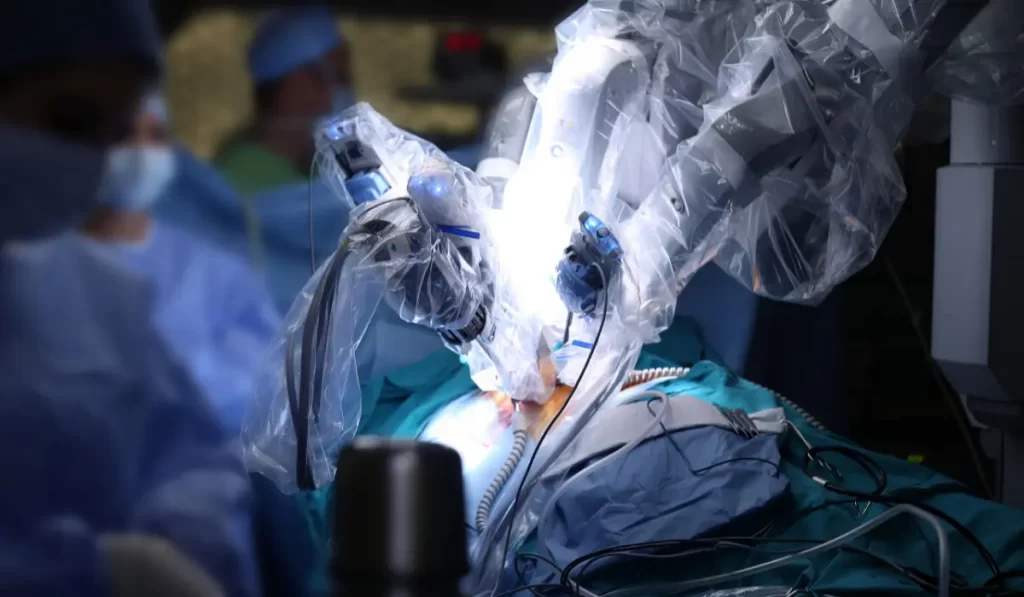
Your surgeon can create a personalized treatment plan tailored specifically to you and discuss all associated risks, benefits, and possible side effects of robotic surgery.
The robot’s control handles are equipped to recognize hand movements of surgeons and transmit force information back to its console, enabling surgeons to perform intricate operations that would be difficult or impossible using handheld instruments alone.
Minimally Invasive Procedures
Minimally Invasive Surgery allows our surgeons to access treatment areas more precisely and provide surgical tools with greater range, flexibility, and range-of-motion than laparoscopic methods can. Through using thin flexible tubes with cameras attached and miniaturized instruments inserted through small incisions. Our technology allows our surgeons to access areas for treatment more easily while still offering greater precision, flexibility, and range-of-motion than other techniques such as laparoscopy.
Operating from a console in the operating room, our surgeons use robotic arms to hold and maneuver small surgical instruments inserted through keyhole-sized incisions. A video camera provides magnified 3D images of the surgical site for further accuracy.
Surgical robots can be used for an array of common surgical procedures. Hospitals that have implemented this technology have seen a noticeable and immediate rise in robotically assisted procedures performed; however, current robotic technology poses several significant limitations which limit its utility – these include its high cost and lack of haptic input (touch feedback). Furthermore, more high-quality clinical trials must be performed to evaluate its efficacy and safety.
Ergonomic Advantages
An experienced surgeon can perform robotic procedures through tiny incisions in your body by inserting miniaturized instruments and a HD camera into tiny ports on your skin, and controlling it from a console nearby. The system then translates these movements into precise movements inside your body allowing for minimally invasive surgeries that were previously only possible through open incision.
Surgeons working on robotic systems report faster learning and peak performance times than with laparoscopic equipment, likely due to its ergonomic features – including an unshakeable camera platform and instrument design that minimizes human tremor.
Additionally, many surgical robotic systems allow surgeons to sit at a console during procedures instead of standing up on an operating table, which reduces stress on his or her back and shoulders and could help decrease surgeries that require lengthy recovery periods for surgeons.
Increased Precision
Robotic surgery offers surgeons a way to perform complex operations through small incisions with reduced trauma. Furthermore, sophisticated cameras provide high definition 3D visualization that surpasses that of the naked eye.
Robotic surgery offers precision that reduces the need for more aggressive treatments and can significantly improve long-term outcomes for patients living in medically underserved or economically disadvantaged communities who may not have access to traditional surgical options.
Surgical robots are designed to allow greater dexterity than laparoscopic instruments, which often have limited range of motion and could potentially cause inadvertent damage during endoscopies or sigmoidoscopies. Unfortunately, traditional systems such as da Vinci and ZEUS models are too large and cumbersome to maneuver easily in tight spaces or maneuver into hard-to-reach parts of anatomy; hence the introduction of semi-active and master-slave robotic systems with preprogrammed equipment and surgeon controlled components.
Enhanced Visualization
Robotic systems’ mechanical arms can reproduce the movement of surgeons’ hands with impressive accuracy, increasing dexterity while also restoring proper hand-eye coordination and creating an ergonomic position for surgery – thus eliminating one major obstacle to laparoscopic procedures.
Therefore, surgeons are able to easily visualize their surgical field from a seated position without requiring patients to lie on operating tables. This provides a three-dimensional view of the surgical site that allows them to identify critical structures and perform complex procedures more easily.
Robotic systems can help reduce blood loss and postoperative complications for patients, leading to shorter hospital stays for them and improving overall quality of life while decreasing healthcare costs associated with extended hospital stays [35].








